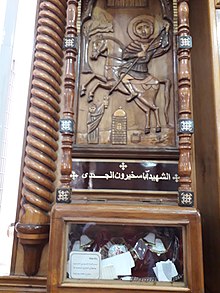
Menas of Egypt, a martyr and wonder-worker, is one of the most well-known Coptic saints in the East and the West, due to the many miracles that are attributed to his intercession and prayers. Menas was a Coptic soldier in the Roman army martyred because he refused to recant his Christian faith. The common date of his commemoration is November 11, which occurs 13 days later on the Julian calendar.
Samuel the Confessor is a Coptic Orthodox saint, venerated in all Oriental Orthodox Churches. He is most famous for his torture at the hands of the Chalcedonian Byzantines, for his witness of the Arab invasion of Egypt, and for having built the monastery that carries his name in Mount Qalamoun. He carries the label "confessor" because he endured torture for his Christian faith, but was not a martyr.

Theodore Stratelates, also known as Theodore of Heraclea, was a martyr and Warrior Saint in the Eastern Orthodox, Catholic and Oriental Orthodox Churches.

The Monastery of Saint Pishoy in Wadi El Natrun, Beheira Governorate, Egypt, is the most famous monastery of the Coptic Orthodox Church of Alexandria named after Pishoy. It is the easternmost of the four current monasteries of Wadi el Natrun.
Saint Dasya the Soldier or Daysa the Egyptian, was a Christian martyr of the third century. He was born in Tanda, Egypt, and served as a soldier in the Roman army. Refusing to deny Christ, Dasya was tortured by Arianus, governor of Ansena, who inflicted great tortures on him, eventually cutting off his head.

Saint Charalampos was an early Christian priest in Magnesia on the Maeander, a city in Asia Minor, in the diocese of the same name. His name Χαράλαμπος means glowing with joy in Greek. He lived during the reign of Septimius Severus (193–211), when Lucian was Proconsul of Magnesia. According to one source, at the time of his martyrdom in 202, Charalambos was 113 years old.
Otimus is a 3rd-century Egyptian martyr and saint. Otimus was born in Fowwa, and later became its priest. After some time, he moved to the mountain of Ansena. When Emperor Diocletian incited his persecution against the Christians, Arianus the governor of Ansena called for Otimus and ordered him to worship the idols. When Otimus refused, Arianus tortured him and eventually ordered him to be burned on 3 Pashons. The relics of Otimus are believed to be in the city of Kalabsha.
Saint Epimachus of Pelusium was an Egyptian martyr.

Saint Moura, also known as Mart Moura, is a Christian martyr of the third century and is honored in Egypt and the Middle East. Her feast is celebrated on 3 May and on 25 September, 5 Hathor and 8 Pashons in the Coptic church. Several churches are dedicated to her, especially in northern Lebanon, as well as a monastery in Ehden.

Coptic monasticism was a movement in the Coptic Orthodox Church to create a holy, separate class of person from layman Christians.

Saint Paraskevi of Rome is venerated as a Christian martyr of the 2nd century. She was arrested and tortured under the reign of the Roman Emperor Antoninus Pius for her refusal to worship idols. Though he eventually released her after she performed a miracle that cured him of his blindness, she was arrested on multiple later occasions for her Christianity and was eventually beheaded by the Roman governor Tarasius.
Saint Mohrael is a Coptic Saint and Martyr. She was martyred in the 4th century AD at the age of 12 years.

Mercurius was a Roman soldier of Scythian descent who became a Christian saint and martyr. He was born in the city of Eskentos in Cappadocia, in Eastern Asia Minor. According to Christian tradition, he was the soldier who killed Julian the apostate during his campaign in Persia. Saint Mercurius was also widely known by his Arabic-language name Abu-Sayfain, Abu-Sifin or Abu-Sefein in Egyptian Arabic which means "father of two swords", referring to the second sword given to him by the Archangel Michael.

Saint Demiana and the 40 Virgins was a Coptic martyr of the early fourth century.

Abanoub or Abanop or Abanoub Al-Nahisy, is a 4th-century Christian saint and martyr from Egypt. His name means Father of Gold in Coptic. He was born in Nehisa in the Nile Delta to Christian parents. Abanoub was 12 years old when he was killed and beheaded, after being tortured for refusing to leave Christianity. His feast day is July 31. His relics are preserved in St.Virgin Mary and St.Abanoub Churches in Sebennytos, Egypt. His title is often The Child Martyr.
Saint Misael the Anchorite was a Christian monk who is venerated by the Coptic Orthodox Church.
Saint George of Assiut was an Egyptian bishop of the Coptic Orthodox Church.
Saint Arianus was a historically attested governor of Ansena in Egypt and a notable figure in the Diocletianic persecution. He is a recurring character in Coptic hagiography, wherein he often attempts to torture Christian martyrs into worshiping idols, gets frustrated with their resilience and has them beheaded. In these hagiographies he is depicted with a sadistic fondness for torture, employing various methods such as beating, combing, nailing, burning, imprisoning, crucifying, and spearing Christians.
Koiak 7 - Coptic Calendar - Koiak 9











